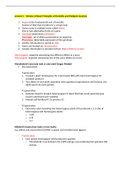Class notes
MBG MIDTERM NOTES - INDEPTH and BASED OFF PREVIOUS EXAMS
- Course
- MBG 2040 (MBG2040)
- Institution
- University Of Guelph (U Of G )
An in-depth notebook of all class notes for MBG 2040 midterm exam. Includes all lecture notes, example problems with explanations, and is based off of previous midterm exams. Includes sample mutiple choice questions.
[Show more]



